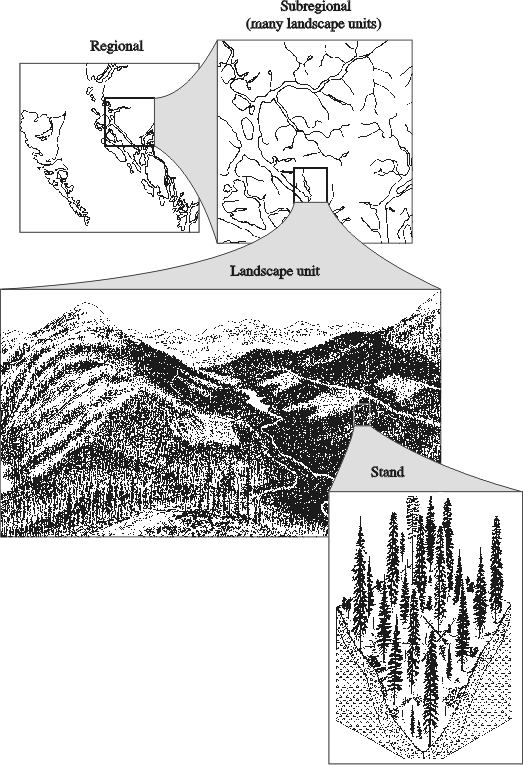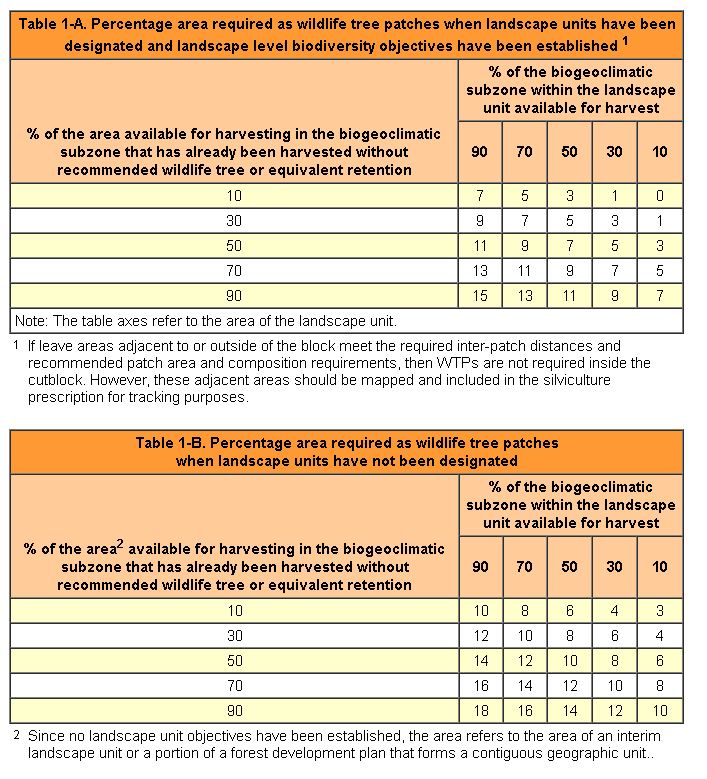1.6 First approach to forest management
We can protect biodiversity with two general approaches to forest management.
- Ecosystem or coarse filter approach
- Species-specific or fine filter approach
Ecosystem or coarse filter approach
The ecosystem or coarse filter approach is divided into three subheadings:
- Landscape level concept and the ecosystem approach to biodiversity management
- Natural disturbance processes
- Stand level disturbance processes
The coarse filter approach:
- Protects ecosystem function
- Provides a broad range of habitats for a broad range of species
The coarse filter approach focuses on managing ecosystems and their natural processes. Most stand level elements (including stand structure, wildlife trees, and coarse woody debris) are maintained through the maintenance (or mimicking) of ecosystem processes and disturbance patterns.
An example of the coarse filter approach: By managing the extent and distribution of a particular age class of forest in a watershed, numerous smaller habitats, communities and associated life forms and processes also are maintained.
The expectation is that the needs and functional capacity of most organisms and processes are fulfilled (or filtered out) by managing habitats at the landscape level. This umbrella style approach is often called coarse filter management.
The coarse filter approach attempts to manage a broad range of habitats that are necessary to maintain the natural diversity of species, ecosystems, and ecosystem processes. This approach:
- Recognizes species and processes are interdependent
- Accounts for changing, yet stable, nature of ecosystems
- Permits blending of social values with environmental values
- Can manage a broad spectrum of species and ecosystems
- Is flexible enough to permit ecosystem management at different planning levels
- Is not suitable for individual species requiring protection
The essence of the coarse filter approach in a single statement: The coarse filter approach tries to manage a forest so that some natural habitats are maintained.
For example, in a watershed or TFL, valuable stream habitat is protected in riparian management areas. Not only does this protect water quality and fish, but it helps all the other animals and plants that live there too.
Because of the tremendous ecological variation found in British Columbia, it would be too complex to try to manage for all species on every hectare of land, nor can we manage for each species individually. A more workable and ecologically sound approach is to adopt an ecosystem management or coarse filter strategy.
Ecosystem management (coarse filter strategy) assumes that:
- Management disturbances should be consistent with conditions under which natural species, gene pools, communities, ecosystems, and ecosystem processes evolved
- The more closely that managed disturbances emulate natural disturbances, the lower the risk of losing natural biodiversity
Ecosystem management focuses on managing ecosystem processes and attributes rather than managing individual components. This approach involves maintaining:
- The integrity of ecosystem processes
- The full range of types of habitats and seral stages representative of a particular ecosystem
- The essential structural attributes of each type of habitat
A fundamental premise for maintaining biological diversity is to implement strategies at both the landscape and stand scales. See illustration, left.
There is a link between how much retention of stand structure is required at the stand scale and how much should be retained across the landscape.
When landscape units have been designated and landscape level biodiversity objectives are established, the requirement for maintaining biodiversity in individual stands can be reduced. Government mandated levels of retention can be determined from Table 1-A (left).
As a result, the development of landscape unit objectives will allow for greater flexibility at the stand level. When no landscape unit biodiversity objectives have been established, appropriate stand scale retention levels should be determined from Table 1-B (left).
Ideally, stand level practices should reflect the naturally occurring patterns of disturbance found on the landscape. For example:
- Smaller, irregular shaped cutblocks can mimic small-scale windthrow events and root rot centres;
- Large cutblocks with scattered riparian leave strips, or island remnants (such as veteran trees), can mimic larger stand-initiating wildfires and insect epidemics;
- Stand level practices should reflect the landscape level disturbance history as well as current levels of management disturbance.
The choice of silvicultural system, and the location, pattern and size of reserves should reflect natural disturbances and overall management objectives. This will influence stand structure and consequently the maintenance of stand level biodiversity.





